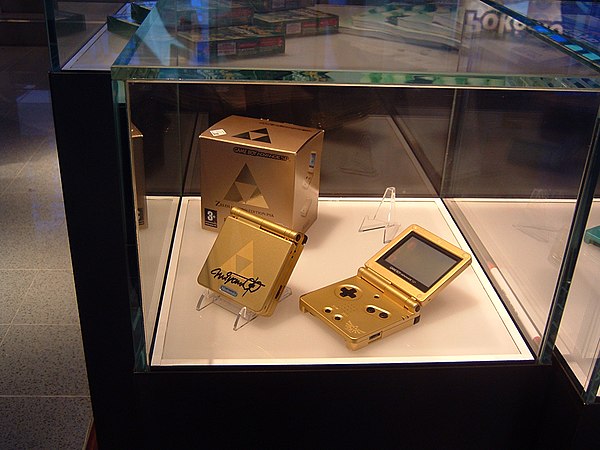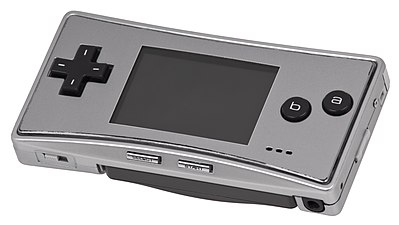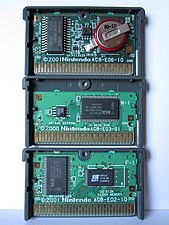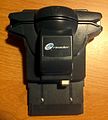History of video games/Platforms/Game Boy Advance
-
Two golden Legend of Zelda themed Game Boy Advance SP handhelds at Nintendo World Store in 2005, signed by Mario and Zelda creator Shigeru Miyamoto.
History
[edit | edit source]Development
[edit | edit source]Game Boy Advance, then known as the Advanced Game Boy (AGP) development started after the launch of the Game Boy Color in 1998, taking just two years.[1]
The Game Boy Advance development kit was spartan, consisting of a caseless circuit board with attached components and little more.[2]
During the development of the Game Boy Advance SP, a glasses free 3D screen was considered, but was not pursued due to the limited resolution possible on the Game Boy Advance making the stereoscopic effects poor.[3] Such a screen would later be implemented once technology improved on the Nintendo 3DS line of consoles.
Misinformation about the Game Boy Advance prior to launch was not uncommon, with at least one major news outlet incorrectly saying in May 2000 that the system would have wireless networking and be internet capable.[4] Demonstration Game Boy Advance consoles were playable at Spaceworld 2000 in August 2000.[5]
Launch
[edit | edit source]The original Game Boy Advance was released in March of 2001.[6][7]
Revisions and the Three Pillar Strategy
[edit | edit source]Who are you?—Slogan for the Game Boy Advance, IGN article[8]
The Game Boy Advance SP was released in 2003.[9] Nintendo also launches the "Who are you?" marketing campaign in 2003.[10]
For a short period of time after 2004, Nintendo marketed both the Game Boy Advance and the Nintendo DS at the same time. This was known as the three pillar strategy, referencing Nintendo's home console (Initially the GameCube), the Game Boy Advance, and the Nintendo DS being targeting at different market segments. Early Nintendo DS consoles were backwards compatible with the Game Boy Advance, helping gamers make the transition and allowing the Game Boy Advance library to be used on a newer system.
The Game Boy Micro was released in September 2005 for $99.99.[11][9]
In 2006 the Visteon Dockable Entertainment was released, which was a portable DVD player with an officially licensed Game Boy Advance built in.[12]
Legacy
[edit | edit source]The GBA was discontinued in Japan in 2006, North America in 2008 and finally in a few other regions in 2010.[13] This marked the end of the Three Pillar strategy, and the Nintendo DS line would supplanting the Game Boy line with the DS line entirely, in addition to shedding Game Boy Advance backwards compatibility with later models.
81.51 million Game Boy Advance consoles were sold.[14]
The low spec full length movies distributed on Game Boy Advance cartridges inspired some to unofficially continue the format, with new unofficial releases as recently as 2021.[15]
Technology
[edit | edit source]Compute
[edit | edit source]A 32 bit ARM7TDMI based CPU clocked at 16.78 MHz powers the GBA.[16][17] On the same package a Sharp LR35902 CPU is used for backwards compatibility clocked at either 4.2 MHz for GameBoy games or 8.4 MHz for GameBoy color games.[17]
The Game Boy Advance has 256 kilobytes of RAM and 32 kilobytes of WRAM.[18] The Picture Processing Unit (PPU) has access to 64KB of VRAM for Backgrounds, 32KB of VRAM for sprites, 1 KB of PAL RAM for Palette information, and 1 KB of OAM for sprite attributes.[19][17]
The Game Boy Advance lacked dedicated 3D acceleration hardware, but was speedy enough to render very simple 3D graphics in software, which done by some games.[20]
Though there are great architectural differences, the Game Boy Advance is often called a portable Super Nintendo Entertainment System due to their similar capabilities. While this is not accurate in terms of technology, it is a fairly useful generalization.
Output
[edit | edit source]The original GameBoy advance has a 40.8 millimeters by 61.2 millimeters Thin Film Transistor display that can display 32,768 colors simultaneously in bitmap mode, or 511 colors simultaneously in character mode.[16] The display has a resolution of 240 x 160 pixels.[16][18]
The Game Boy Advance can generate PCM sounds.[18]
Power
[edit | edit source]The original GameBoy Advance takes 2 AA batteries, lasting about 15 hours.[16]
The GameBoy Advance SP instead used a rechargeable lithium ion chemistry battery, and could power the system for about 7 to 10 hours while using screen lighting.[21]
Accessories
[edit | edit source]In 2004 an accessory was released in Japan allowing for the Game Boy Advance to be used as a mobile video phone.[22]
Notable Games
[edit | edit source]2001
[edit | edit source]Advance Wars
[edit | edit source]A turned based strategy game and an iconic entry in the Wars series. This game notably focused on the effect a commanding officer (CO) would have on their troops.
Read more about Advance Wars on Wikipedia.
2002
[edit | edit source]Pokémon Ruby and Sapphire
[edit | edit source]Game director, designer, and composer Junichi Masuda stated that Ruby and Sapphire were the most challenging games to make, mostly for social reasons rather then technical ones.[23]
The region of Ruby and Sapphire is actually based on a map of Kyushu, rotated for gameplay reasons.[24]
The OST of Ruby and Sapphire is well known for it's heavy usage of trumpets.
Read more about Pokémon Ruby and Sapphire on Wikipedia.
Metroid Fusion
[edit | edit source]Widely considered to be among the best 2D Metroid games.
Read more about Metroid Fusion on Wikipedia.
Mega Man Battle Network 3
[edit | edit source]The plot of this game included an arc focusing on the serious theme of hospitalization, and notably included a subplot about a hospital being unable to continue normal operations due to a cyberattack.[25] While the cyberattack presented in the game is quite fanciful, this bit of speculative fiction is still striking, because by 2003 such an idea was essentially a what-if scenario.[26] Eventually such fears would become reality, when the WannaCry ransomware attack battered hospital operational capacity internationally in 2017.[27]
Read more about Mega Man Battle Network 3 on Wikipedia.
2003
[edit | edit source]
Boktai: The Sun is in your Hand
[edit | edit source]Boktai is designed by Hideo Kojima, and uses a cartridge with a light sensor to have real world conditions affect gameplay.[28]
Read more about Boktai: The Sun Is in Your Hand on Wikipedia.
Mega Man Battle Network 4
[edit | edit source]This game introduced an updated art style to the series, though opinions on this decision are mixed.[29][30]
Read more about Mega Man Battle Network 4 on Wikipedia.
2004
[edit | edit source]The Legend of Zelda: The Minish Cap
[edit | edit source]A top down 2D Zelda series game developed by Capcom and Flagship. The game was published by Nintendo, which managed production.
The defining feature of The Minish Cap was for the player to shrink down to small sizes to explore hidden aspects to the everyday world and dungeons. The sprite art of the game managed to evoke the cell shaded style of the contemporary home console game, The Legend of Zelda: The Windwaker despite being in a different medium. In it's time the Minish Cap was very well received.
Read more about The Legend of Zelda: The Minish Cap on Wikipedia.
Pokémon FireRed and LeafGreen
[edit | edit source]Enhanced remakes of Pokémon Red and Green. These games introduced a new subregion for players to explore called the Sevii Islands.
Read more about Pokémon FireRed and LeafGreen on Wikipedia.
Pokémon Emerald
[edit | edit source]An enhanced version of Pokémon Ruby and Sapphire. It is considered by many to be the definitive version of the game due to a number of improvements made, including the Battle Frontier in game area and the addition of in-battle Pokémon animations.
Read more about Pokémon Emerald on Wikipedia.
Asterix & Obelix XX
[edit | edit source]A 3D platformer on the GBA praised for it's graphics which were similar to those found on the original PlayStation.[31][32]
Read more about Asterix & Obelix XXL on Wikipedia
2005
[edit | edit source]2006
[edit | edit source]Mother 3
[edit | edit source]The final game in the Mother series. It was infamously never saw an official English release, with a number of reasons speculated as to why.[33][34]
In 2021 a number of notable public figures in the gaming industry made note of the game.[35][36]
Read more about Mother 3 on Wikipedia.
2022
[edit | edit source]OpenLara port of Tomb Raider
[edit | edit source]A reverse engineered port of the 3D game Tomb Raider attracted widespread media attention in 2022.[37][38]
Special Edition Game Boy Advance
[edit | edit source]Original Design
[edit | edit source]- Space World 2000 Silver and Teal - Produced but not sold.[39]
Game Boy Advance SP
[edit | edit source]- Char edition - Late 2003 Game Boy Advance SP with red color and decal themed around the character Char Aznable, nicknamed "The Red Comet", from Mobile Suit Gundam.[40]
- Pikachu Gameboy Advance SP[41]
Gallery
[edit | edit source]Game Boy Advance
[edit | edit source]Game Boy Advance SP
[edit | edit source]Game Boy Micro
[edit | edit source]-
The Game Boy Micro
-
A number of Game Boy Micros
Game Cartridges
[edit | edit source]-
Various GBA game boxes and cartridges.
-
Various GBA cartridge circuit boards.
-
A counterfeit GBA cartridge.
Accessories
[edit | edit source]Color palettes
[edit | edit source]-
Simulated Game Boy Advance color palette in 32 color mode.
-
Simulated Game Boy Advance color palette in 32,768 (32k) color mode.
Marketing
[edit | edit source]-
Original Game Boy Advance logotype.
-
Game Boy Advance SP logotype.
-
Game Boy micro logotype.
Trivia
[edit | edit source]
At least one piece of medical equipment reused a Game Boy Advance display.[42]
The Game Boy Advance itself could be used as a glucose tester after the GlucoBoy cartridge was released in 2007 after being in development since at least 2004.[43]
Development
[edit | edit source]There is a Wikibook on GBA Development.
External Resources
[edit | edit source]References
[edit | edit source]| Parts of this page are based on materials from: Wikipedia: the free encyclopedia. |
- ↑ "A look into Nintendo's unreleased Game Boy successor" (in en). Nintendo Everything. 17 April 2016. https://nintendoeverything.com/a-look-into-nintendos-unreleased-game-boy-successor/. Retrieved 26 October 2020.
- ↑ "Nintendo’s GBA Dev Board Could Pass For Modern DIY". Hackaday. 5 June 2020. https://hackaday.com/2020/06/04/nintendos-gba-dev-board-could-pass-for-modern-diy/. Retrieved 25 October 2020.
- ↑ "Iwata Asks". iwataasks.nintendo.com. Retrieved 7 November 2020.
- ↑ Hutsko, Joe (25 March 2000). "88 Million and Counting; Nintendo Remains King of the Handheld Game Players (Published 2000)". The New York Times. https://www.nytimes.com/2000/03/25/business/88-million-and-counting-nintendo-remains-king-of-the-handheld-game-players.html?searchResultPosition=1.
- ↑ "Spaceworld 2000 - Guide". Nintendo World Report. https://www.nintendoworldreport.com/guide/1791/gamecube-faq-spaceworld-2000.
- ↑ "A timeline of Game Boy's record-breaking history as iconic console celebrates 30 years". Guinness World Records. 17 April 2019. Retrieved 14 November 2020.
- ↑ Asarch, Steven (27 March 2023). "22 Years Ago, Nintendo Changed Portable Game Consoles Forever" (in en). Inverse. https://www.inverse.com/gaming/game-boy-advance-22nd-anniversary.
- ↑ "Who Are You SP - IGN" (in en). https://www.ign.com/articles/2004/09/17/who-are-you-sp.
- ↑ a b Byford, Sam (19 April 2019). "Only Nintendo could kill the Game Boy". The Verge. Retrieved 14 November 2020.
- ↑ "Nintendo Asks, 'Who Are You?' ; New Multimillion-Dollar Campaign Helps Players Explore Their 'Inner Gamer' Business Wire". web.archive.org. 18 March 2020. https://web.archive.org/web/20200318033921/https://www.businesswire.com/news/home/20030929005237/en/Nintendo-Asks-New-Multimillion-Dollar-Campaign-Helps-Players.
- ↑ "Nintendo releases GameBoy Micro in the US". Wikinews. 13 September 2005. https://en.wikinews.org/wiki/Nintendo_releases_GameBoy_Micro_in_the_US.
- ↑ McFerran, Damien (6 February 2017). "Video: The Visteon Dockable Entertainment System Is The Biggest Game Boy Advance Ever". Nintendo Life. https://www.nintendolife.com/news/2017/02/video_the_visteon_dockable_entertainment_system_is_the_biggest_game_boy_advance_ever.
- ↑ "7 Things Everyone Should Know About the Game Boy Advance". PCMAG. Retrieved 6 November 2020.
- ↑ "IR Information : Sales Data - Dedicated Video Game Sales Units". Nintendo Co., Ltd. Retrieved 14 November 2020.
- ↑ Faulkner, Cameron (11 March 2021). "A Game Boy Advance might be the best way to watch Tenet, actually" (in en). The Verge. https://www.theverge.com/2021/3/11/22321473/tenet-game-boy-advance-christopher-nolan-bob-wulff-youtube-mod-cartridge.
- ↑ a b c d "Technical data". Nintendo of Europe GmbH. Retrieved 23 October 2020.
- ↑ a b c "Game Boy Advance Architecture A Practical Analysis". Rodrigo's Stuff. 18 August 2019. Retrieved 28 October 2020.
- ↑ a b c "How Game Boy Advance Works". HowStuffWorks. 20 December 2000. Retrieved 28 October 2020.
- ↑ "Gamasutra - Gameboy Advance Resource Management". www.gamasutra.com. Retrieved 28 October 2020.
- ↑ "The History of 3D Graphics on the Gameboy Advance". Retrieved 8 November 2020.
{{cite web}}: Text "minimme" ignored (help) - ↑ "| Nintendo - Customer Service | Game Boy Advance SP - Rechargeable Battery Frequently Asked Questions". www.nintendo.com. Retrieved 22 April 2021.
- ↑ McFerran, Damien (11 February 2022). "Did You Know The Game Boy Advance Could Make Video Calls Back In 2004?". Nintendo Life. https://www.nintendolife.com/news/2022/02/did-you-know-the-game-boy-advance-could-make-video-calls-back-in-2004.
- ↑ Hilliard, Kyle. "Why Ruby And Sapphire Were The Most Challenging Pokémon To Make". Game Informer. Retrieved 28 October 2020.
- ↑ "HIDDEN POWER of masuda". www.gamefreak.co.jp. Retrieved 28 October 2020.
- ↑ "The Best Battle Network (?) - Mega Man Battle Network 3 Review". Retrieved 31 May 2021.
- ↑ Haugh, Richard (June 2003). "Cyber terror". Hospitals & Health Networks. 77 (6): 60–64, 2. ISSN 1068-8838. Retrieved 22 June 2021.
- ↑ Larson, Selena (2017-05-16). "Why hospitals are so vulnerable to ransomware attacks". CNNMoney. https://money.cnn.com/2017/05/16/technology/hospitals-vulnerable-wannacry-ransomware/index.html.
- ↑ "The Kojima Game That Made You Play In The Sun". Kotaku. Retrieved 27 October 2020.
- ↑ Vogel, Mitch (5 June 2015). "Review: Mega Man Battle Network 4 Red Sun & Blue Moon (Wii U eShop / Game Boy Advance)". Nintendo Life. https://www.nintendolife.com/reviews/wiiu-eshop/mega_man_battle_network_4_red_sun_and_blue_moon_gba.
- ↑ "A Mega Lack of Polish - Mega Man Battle Network 4 Review". YouTube. KNIJohn. Retrieved 14 May 2021.
- ↑ "Asterix & Obelix XXL - IGN". Retrieved 8 November 2020.
- ↑ "Astérix & Obélix XXL – Hardcore Gaming 101". Retrieved 8 November 2020.
- ↑ "Nintendo Allegedly Cancelled Localisation Of Mother 3 Due To Its Controversial Aspects". Nintendo Life. 12 February 2019. https://www.nintendolife.com/news/2019/02/nintendo_allegedly_cancelled_localisation_of_mother_3_due_to_its_controversial_aspects.
- ↑ "15 Years Later, This Nintendo Gem STILL Hasn't Been Localized". CBR. 13 April 2021. https://www.cbr.com/mother-3-localization-nintendo/.
- ↑ "Random: Reggie Says He's Got An English Version Of Mother 3, But Still Hasn't Played It". Nintendo Life. 17 April 2021. https://www.nintendolife.com/news/2021/04/random_reggie_says_hes_got_an_english_version_of_mother_3_but_still_hasnt_played_it.
- ↑ "Terry Crews Demanding the Localization of Mother 3 is Your Friday Mood - IGN" (in en). https://www.ign.com/articles/terry-crews-demanding-the-localization-of-mother-3-is-your-friday-mood.
- ↑ "Someone Got PS1 Classic Tomb Raider Running On A Game Boy Advance" (in en-us). Kotaku. https://kotaku.com/someone-got-ps1-classic-tomb-raider-running-on-a-game-b-1848367887.
- ↑ "Random: The OG Tomb Raider Looks Amazing On Game Boy Advance". Nintendo Life. 15 January 2022. https://www.nintendolife.com/news/2022/01/random-the-og-tomb-raider-looks-amazing-on-game-boy-advance.
- ↑ "The Legendary Silver and Teal Game Boy Advance, From Space World 2000, Has Been Found". Nintendo Life. 30 April 2021. https://www.nintendolife.com/news/2021/04/the_legendary_silver_and_teal_game_boy_advance_from_space_world_2000_has_been_found.
- ↑ "Bandai Shows off Special GC and GBA - News". Nintendo World Report. Retrieved 30 November 2020.
- ↑ "EXTREMELY RARE Unboxing: Pikachu Gameboy Advance SP". Retrieved 19 August 2021.
- ↑ "Game Boy Advance Hiding In A Medical Device". Hackaday. 24 September 2017. https://hackaday.com/2017/09/24/game-boy-advance-hiding-in-a-medical-device/. Retrieved 25 October 2020.
- ↑ "GlucoBoy turns diabetes blood-testing into a game". Engadget. Retrieved 6 November 2020.































